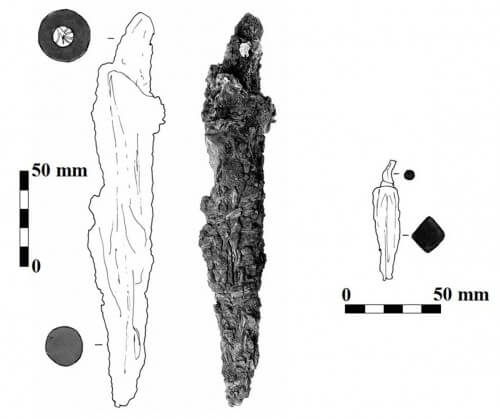Chemical and microscopic characterization of arrowheads from the 13th century discovered in Apollonia-Arshoff provide evidence for the story of the fall of the city

The archaeological site of Apollonia-Arshoff, located on the coast of Herzliya, has a long and turbulent history. The settlement of Arshof (or Arshef) was established at the beginning of the Persian period (6th to 4th century BC) by the Phoenicians, and was named after the Phoenician storm god, Reshef. In the Hellenistic period, Apollonia was named after the god Apollo, who was identified with the god Reshef. The city went through many upheavals and changed many masters until it fell in 1101 to the Crusaders, who built a fortress in it in 1241. In 1261, control of the fortress and the city passed to the order of the Hospitallers. In March 1265, the Mamluk sultan Baybers came at the head of his armies against the city that fell into his hands after a 40-day siege. Beavers destroyed Apollonia's walls and citadel, and it has remained abandoned ever since.
Arrowheads from the 13th century discovered in Apollonia-Arshoff. On the right: a small arrowhead with a square section, on the left: an extremely large arrowhead, which was probably used by the Mamluks to set fire to the doors of the fortress gates, around which a rope was wound.
Several rounds of excavations have been conducted at the site, which have been directed since 2006 by Professor Oren Tal from the Institute of Archeology of Tel Aviv University. The findings of the excavations provide a fascinating look at the occupation of the city and its destruction by the Mamluks. The silent witnesses to the drama that unfolded in the city are arrowheads discovered in excavations and studied using archaeo-metallurgical methods.
Throughout the fort, more than 1,200 iron arrowheads were discovered that the Mamluks shot at the defenders. Most arrowheads are normal for their period and are between 4 and 6 inches long. The arrowheads were all discovered in an oxidized state as a result of the intense fire that destroyed the fort during the battles, and also as a result of fusion processes (corrosion), which caused the destruction of the material as a result of chemical reactions with its environment in the sandstone where they were buried.
In order to reconstruct the production processes of the arrowheads, we performed their chemical analysis alongside observing the microscopic structure, measuring the morphology of the iron grains and mechanical tests. The tests revealed that in the initial phase the raw iron was produced from iron ore in a solid state using ancient technology (as opposed to modern methods of casting from molten metal). Then the iron is heated to a high temperature until bleached iron is obtained and then worked into the desired shape while repeatedly hitting with hammers. Finally, the finish was completed through cold processing which hardened the surface of the arrowheads. The evidence for the forging process emerges from the heterogeneous microscopic structure of the arrowheads.
However, among the hundreds of arrowheads that were discovered, three particularly large arrowheads stood out (see illustration). The length of one of them, which was preserved intact, was 21 centimeters, and of the other two, also large, fragments were discovered. A microscopic examination of these arrowheads revealed a different structure of iron cores, indicating that they were prepared by a different production method. The common arrowheads were produced by forging from the raw iron, while the large arrowheads were produced using composite material technology by folding welded layers like a deck of cards. The differences in the production method and structure indicate a special role of the large arrowheads in the battle. If so, what was the function of these arrowheads?
The large arrowheads were discovered between the two gate towers of the fort, so it must be assumed that they were shot by the Mamluks. Upon careful examination, we found in the center of the large arrowheads the remains of wooden sticks made from the branches of the Eretz Israel, processed and threaded into the cores of the arrowheads.
But the important find was the remains of ropes that were preserved around one of the arrowheads and suggest that the large arrows were used by the Mamluk army to set fire to the citadel gate of the fort. The gate was made of wood, but in order to set it on fire it was necessary to penetrate through metal plates that covered it with extremely large arrows. We hypothesize that the Mamluks wrapped cloth around the large arrows, tied them with ropes, dipped them in oil or some other inflammable substance and then shot them towards the gate using a slingshot machine. This archaeological hypothesis is supported by the presence of certain iron oxides that are only formed at high temperatures and by the fact that the metal nuclei were oxidized even before the fusion began. These metallurgical evidences therefore tell of the edge of Apollonia in high temperature fire.
____________________________________________________________________________________________________________________________________________________________________
About the author
Dr. Dana Ashkenazi from the School of Mechanical Engineering at Tel Aviv University serves as the spokesperson for the Israeli Association for Materials and Processes. Dr. Oz Golan from the Department of Mechanical Engineering at Afka Academic College serves as the Secretary of the Israeli Association for Materials and Processes and as the Head of the Materials Branch at the Chamber of Engineers. Prof. Oren Tal, Head of the Department of Archeology and Ancient Near Eastern Civilizations at Tel Aviv University manages the archaeological excavation project in Apollonia-Arshoff.
